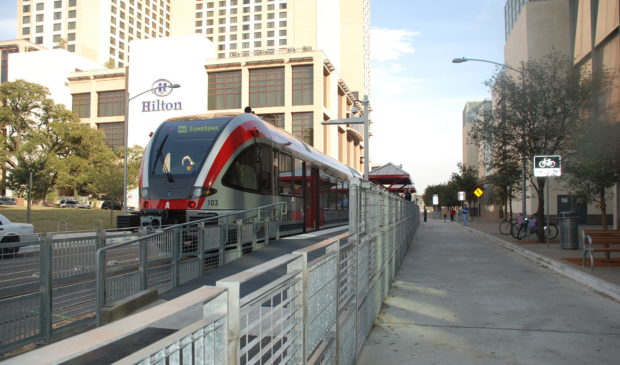Downtown change: new rail station, more two-way traffic
Friday, May 5, 2017 by
Jack Craver In two votes Thursday, City Council approved funding to help the Capital Metropolitan Transportation Authority build a new downtown rail station and public plaza to serve the Red Line and gave the OK to turn East Fifth Street into a two-way street to help ease the congestion that the new development is expected to exacerbate.
Transportation Director Robert Spillar explained that $500,000 will add the westbound lane to Fifth Street. That new lane is aimed at reducing congestion that results from the frequent closures of parts of East Sixth Street during the weekends and special events.
The new lane will also coincide with the construction of a new rail station and public plaza on Fourth Street, between Red River and Trinity streets. The plan will also prohibit cars on that section of Fourth Street.
Council Member Ora Houston suggested that the solution to the issues Spillar described might be “flexible routes,” whereby the direction of streets switches based on schedule. Spillar replied that in the past Council had instructed the Transportation Department to avoid “reversible streets” and that they often lead to confusion.
Brazos Street was once one-way, noted Spillar, and plans to make it two-way encountered resistance from residents, he recalled. Now, he added, people are satisfied with the change.
Houston, however, countered that she did not judge Cesar Chavez Street, which was once a one-way street, to be a great success.
“I saw Cesar Chavez go to two-way and now it’s totally blocked up,” she said.
Council Member Pio Renteria later noted that traffic on Cesar Chavez Street originally moved in both directions and that the street became a one-way road in the 1980s. A number of accidents, he said, had compelled the city to make it a two-way street again.
Meanwhile, Mayor Pro Tem Kathie Tovo expressed deep skepticism of the rail station plan. Although it is a project being run by Capital Metro, the city will contribute up to $3 million to fund storm drain improvements in the surrounding area and will waive a number of development fees for the transit agency.
And yet, she noted, the station won’t even include the public restroom that Capital Metro leaders had initially suggested would be part of the plan.
“Most train stations have public restrooms,” said Tovo, who has also been pushing to put in place a separate public restroom downtown in response to issues of people relieving themselves outdoors. Houston echoed Tovo’s concerns, saying that those who take a 35-minute train ride should be able to expect a bathroom upon arriving downtown.
Javier Arguello, director of long-range planning at Capital Metro, responded that while a bathroom was considered as part of the initial plans, it was excluded due to the high cost of maintaining one.
Council Member Ann Kitchen pushed back on Tovo’s concerns about the spending. Capital Metro, which is entirely dependent on sales tax revenue, has limited funding, she said. It is the city’s duty to chip in for the sake of improved public transit, she argued.
“We all have a responsibility and an opportunity to make an improvement for the community,” Kitchen said, adding that she and others on the Capital Metro Board of Directors would try to get a restroom added to the station as soon as possible.
The final motion included an amendment from Tovo that directed staff “to make it a priority to include public restrooms within the early phase of the project with the strong request that it be a shared expense between Capital Metro and the city of Austin.”
Marshall Jones, who lives at the 555 Condos on East Fifth Street and is president of the the building residents’ homeowners association, spoke against the change. At several community meetings involving Capital Metro staff, he said, nobody other than city and Capital Metro staff spoke in support of the plan.
“They listened, but I don’t think they heard,” he said about the transit staff. “They were all saying, ‘Do you want to lose your arm? Do you want to lose your leg?’ There was never a true conversation about, ‘We want to bring more trains downtown, how can we do so more effectively?’”
Julie Fitch of the Downtown Austin Alliance spoke in favor of the new lane on Fifth Street and the new rail station, describing them as essential improvements to managing downtown traffic and improving regional transportation.
“This is really forward, long-term thinking,” she said.
Both measures ultimately passed easily, 8-2. In both cases, Houston and Council Member Ellen Troxclair were the only dissenters.
This story has been corrected as it originally misidentified the section of Fourth Street that will be closed to cars. Photo by Sahmeditor (Own work) [CC BY-SA 3.0 or GFDL], via Wikimedia Commons.
The Austin Monitor’s work is made possible by donations from the community. Though our reporting covers donors from time to time, we are careful to keep business and editorial efforts separate while maintaining transparency. A complete list of donors is available here, and our code of ethics is explained here.
You're a community leader
And we’re honored you look to us for serious, in-depth news. You know a strong community needs local and dedicated watchdog reporting. We’re here for you and that won’t change. Now will you take the powerful next step and support our nonprofit news organization?









